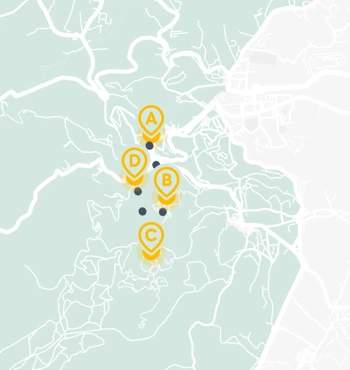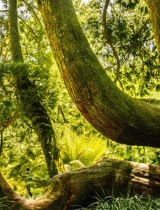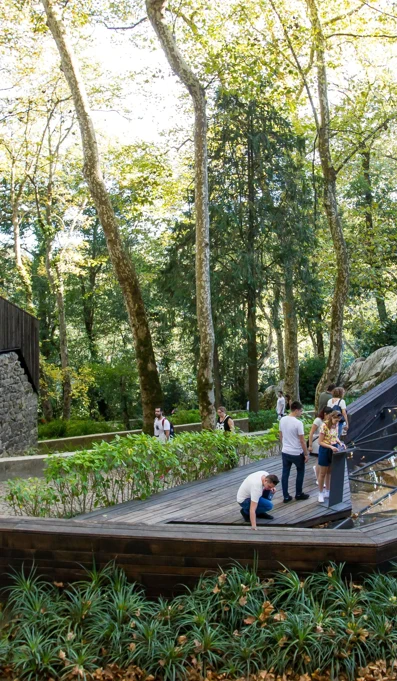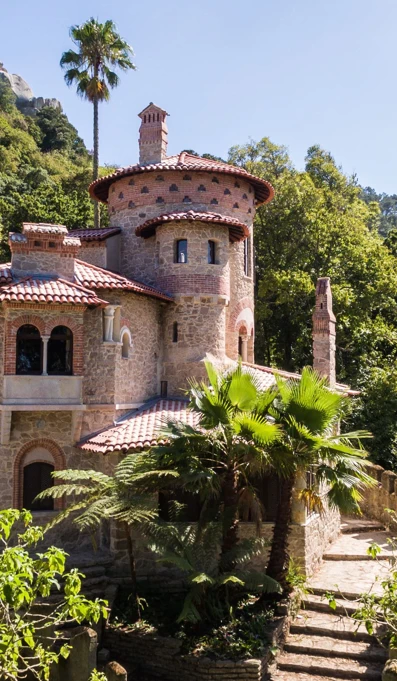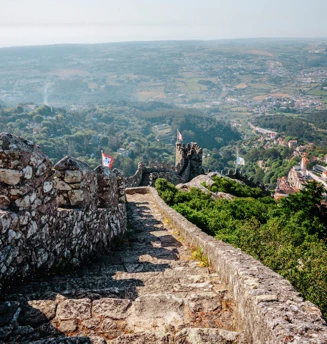
Pedestrian route
The Parks and Monuments of Sintra by foot
National Palace of Sintra + Moorish Castle + Park and Palace of Pena + Vila Sassetti
Sintra is a place with something for everyone. You can discover some of Sintra’s most emblematic monuments in just one day by taking one of these walking routes and drinking in the history and nature around you.
MORNING
The day begins in the heart of the historical centre of Sintra. The National Palace of Sintra, also known as the Town Palace, defines the town’s silhouette with its huge pair of majestic chimneys, which visitors can’t help but notice.
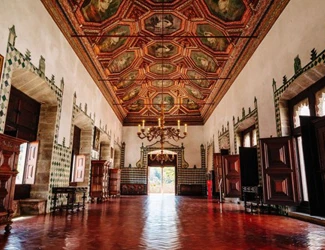
Swan Room
This room is named after the white swans that decorate its ceiling. It is the largest room in the palace and the place where the most important functions were held, such as ambassadorial receptions, banquets and celebrations.
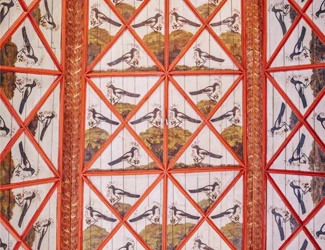
Magpie Room
The name of this room is explained by the 136 magpies painted on the ceiling. The birds hold the banner of King João I in their beaks, with the motto ‘por bem’ (for good), and in their claws grasp a rose that may refer to the House of Lancaster, the house of Queen Philippa, his wife.
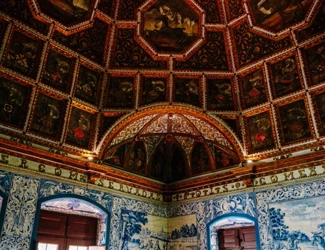
Room of the Coats of Arms
Located in the highest part of the Palace, the Room of the Coats of Arms is the finest example in the building of Manueline intervention and the most important heraldry room in Europe.
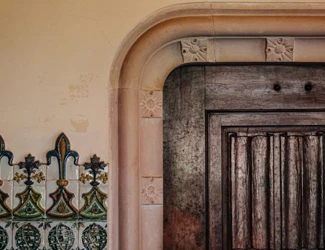
Queen Maria Pia’s Royal Chambers
Located on the upper floor of the east wing of the palace, these chambers were used by Queen Maria Pia of Savoy (1847-1911), the last queen to live in this palace.
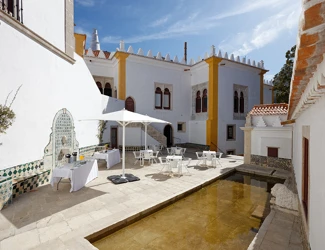
The Lion's Patio Cafeteria
In the Lion's Patio and Garden, you will find a cafeteria with a pleasant terrace, where you can take a break and prolong your experience of the palace.
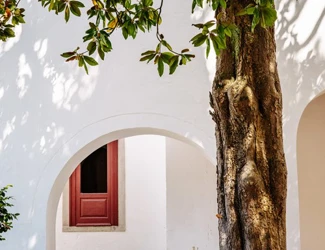
The Preta Garden
After a refreshing break, you can explore the gardens of the National Palace of Sintra. Don’t miss a visit to the recently restored Preta Garden, named after the singular relief figure of a black woman that decorates it.
MORNING
Walk through the historical centre of Sintra to the Church of Santa Maria (approximately 15 min.), then take the walking route from Santa Maria to the Moorish Castle. This walk takes around 45 minutes.
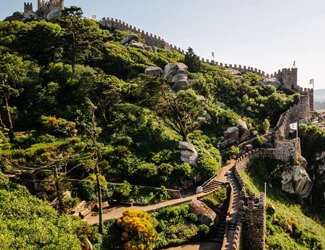
Arms Square
This walled square, open to the sky, was at one time where the military garrison convened. In the 19th century, King Ferdinand II carried out renovations to the castle, transforming it into a romantically-inspired place of contemplation.
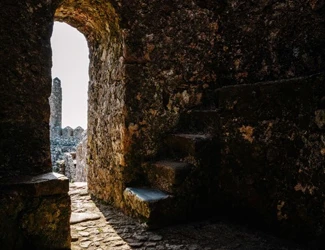
Castle Keep
This was the castle’s last stronghold and includes the Tower Keep. It is located at one of the highest points of the castle walls and offers panoramic views of the plains to the north and the Atlantic ocean.
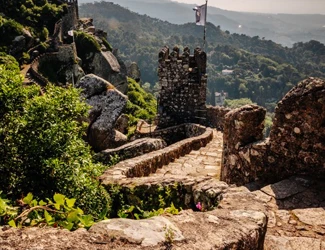
Walls
The various construction phases are visible in the castle walls, showing the alterations that have taken place over time. The sentry walks along the top allow you to contemplate a unique landscape.
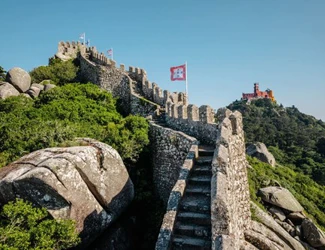
Royal Tower
Located opposite the Castle Keep, the Royal Tower is the highest point on these walls and provides a spectacular view of the Sintra hills and, in particular, the Palace of Pena.
AFTERNOON
To reach the Palace of Pena, follow the signposted footpath as far as the main entrance to the Park of Pena and then climb to the Palace. This walk takes around 30 minutes.
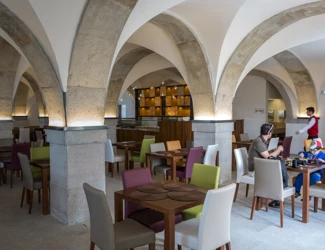
Palace Restaurant
After a fun-filled morning, this is the ideal place for a nice long lunch break.
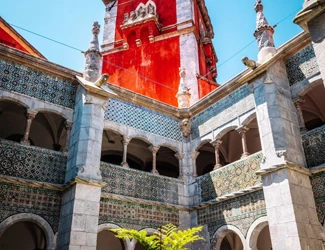
Sixteenth-century Cloister and chambers
The most intimate part of the Palace of Pena, reserved for the royal family and those closest to them, is organised around the sixteenth-century Cloister of the old monastery of Hieronymite monks, which King Ferdinand II adapted into living quarters. On the two floors that surround it, there are various chambers, offices and the Dining Room.
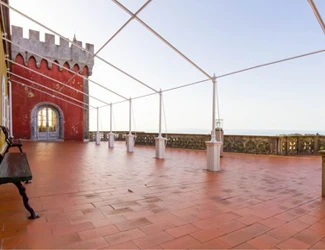
Queen’s Terrace (view over the palace and park)
This south-facing terrace offers a panoramic view over the Park of Pena and the Sintra hills. From here, you can take a closer look at the façade of the New Palace, which was added to the original structure of the old monastery.
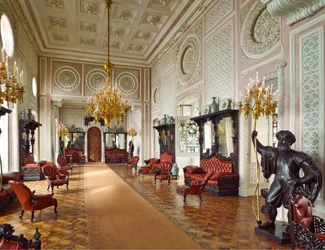
Great Hall
Designed as a courtroom, the Great Hall is the most representative of the Palace of Pena, with the rest of the ‘New Palace’ arranged around it. In this exuberant hall, you can admire the many disciplines used in its decoration, where architecture, a variety of finishes, furniture, textiles and King Ferdinand II’s collection of stained glass come together in harmony.
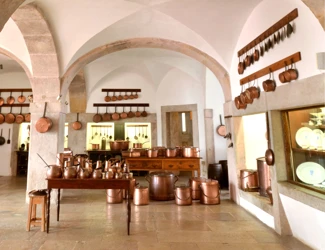
Kitchens
Designed for serving large banquets at festivities, this was the main kitchen of the palace. The elaborate copper utensils are marked with the initials PP (Palace of Pena) and the crowned monogram of King Ferdinand II.
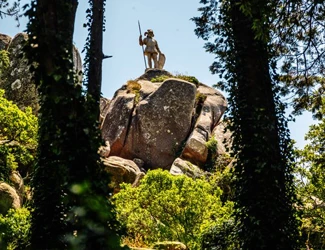
Temple of Columns, The Warrior Statue and The Queen’s Table
We now recommend plunging into the trees in search of some of the secluded spots you can glimpse from the palace terraces. Walking along the winding roads of the park, discover the Temple of Columns, whose yellow dome supported by twelve columns stands out among the treetops. The Warrior Statue can be seen nearby, including, at its feet, an octagonal table which has taken the name of the Queen's Table because it was one of Queen Amelia's favourite places.
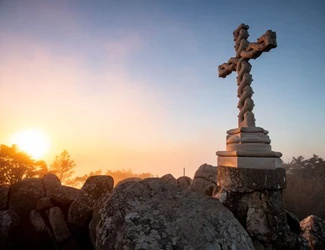
High Cross
Following the path as it climbs from the Queen’s Table, you will reach the highest point in the Sintra hills, the High Cross, at an altitude of 528 metres, from which there is a stunning view of the green hills and plains to the north, the Cascais coast to the south, and the Atlantic Ocean to the west.
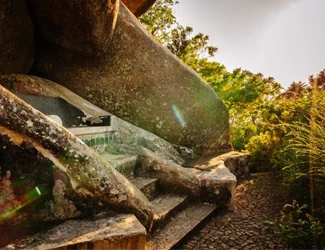
St Catherine’s Heights
From the High Cross, walking the narrow, winding hillside paths through a wood dominated by oaks, chestnuts and beeches, you will discover intimate spots like St Catherine’s Heights, an excellent viewpoint over the palace. Here, you can find a seat sculpted from rock, covered in tar and decorated with tiles, known as the Queen’s Throne, another of Queen Amelia’s favourite places.
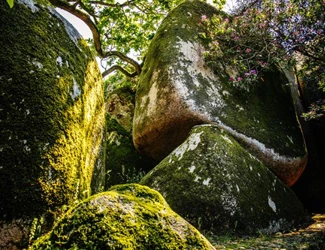
Garden of the Countess of Edla
At the eastern edge of the Park of Pena, you will find the idyllic Garden of the Countess of Edla, with its snaking paths and exotic species. Highlights here include the meticulously planned botanical collections, such as the Countess’ Fernery, which is the oldest collection of arboreal ferns in the park, cut through by a watercourse that forms small lakes and waterfalls, and a remarkable collection of camellias, whose delicate flowers offer a counterpoint to the blooms of the azaleas and rhododendrons.
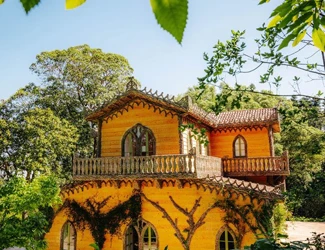
Chalet of the Countess of Edla
In the idyllic setting of the Garden of the Countess of Edla is one of the most beautiful and interesting buildings in the Park of Pena – the Chalet, also known as House of Indulgence (Casa do Regalo) was built as a place of refuge by King Ferdinand II and his second wife, the Countess of Edla.
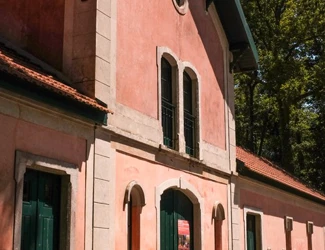
Pena Farm and Stables
This part of the park was created by King Ferdinand II, according to the concept of the Ferme Ornée (Ornamental Farm), where the productive and scenic setting provided pleasant ‘country walks’ in the romantic Pena arboretum. The central, most distinctive part of Pena Farm is the Stables, a building that provided support functions to the farming activities, with stables for the animals. Around the Stables are the enclosures for farm animals, a meadow with spaces to rest or enjoy a picnic and a complex of greenhouses, indispensable for the upkeep of the gardens.
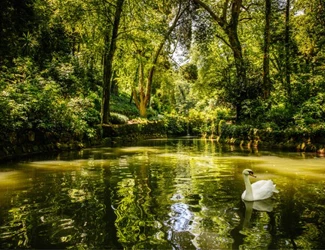
Little Birds Fountain and Valley of Lakes
The valley that splits the Park of Pena (neatly down the middle) is the lowest section of the park, towards which all its watercourses run. This path sets off from the Little Birds Fountain, a small neo-Moorish pavilion containing a small fountain flowing with crystalline water, the sound of which is amplified by the building’s efficient acoustics. The path then skirts five lakes linked by small waterfalls spread along the pleasant, leafy valley, always accompanied by the sound of running water. In the lakes, you will also see two duck-houses, structures to shelter aquatic birds, the architecture of which recalls the two most imposing constructions in King Ferdinand II’s domains.
Leaving the Park of Pena through the Lakes gateway, take the Vila Sassetti Walking Route to return to the Historical Centre of Sintra, enjoying along the way a wonderful garden with panoramic views over the hills and see the main house with its traditional Italian-style architecture.
Walk
You can now walk back to the Historic Center of Sintra through the Villa Sassetti trail.
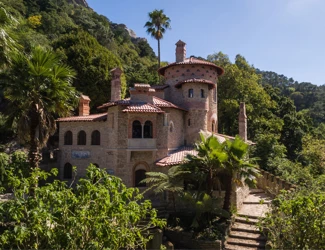
Villa Sassetti
In a sinuous and downward path, take a slow walk and contemplate nature, through a forest of chestnut trees and oaks permeated by water lines and natural rocks. Architecture and landscape merge harmoniously in this garden, designed by the scenographer Luigi Manini (1848-1936), and the exotic vegetation, the water features and the contrasts of light and shadow convey the landscape strongly scenographic traits. The house, located halfway down the slope, was designed as a summer refuge for Victor Carlos Sassetti (1851-1915), owner of the legendary Hotel Braganza, in Lisbon, and the Hotel Victor, in Sintra. Also designed by Luigi Manini, it is inspired by the castles of northern Italy, where the architect and the Sassetti family were from.
Importante information

National Palace of Sintra
Info
The Moorish Castle
Info
Park and National Palace of Pena
Info
Vila Sassetti
InfoBuy multiple tickets at once and enjoy a discount.
Buy Tickets

